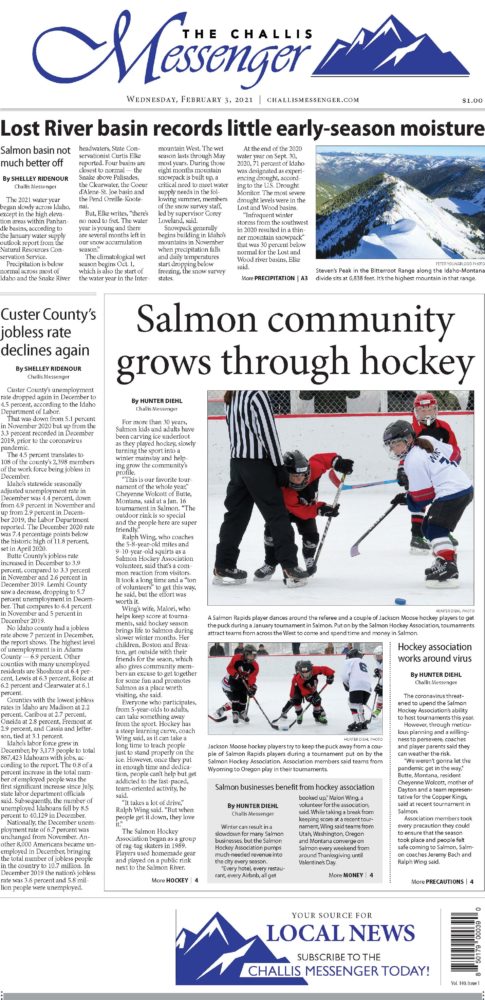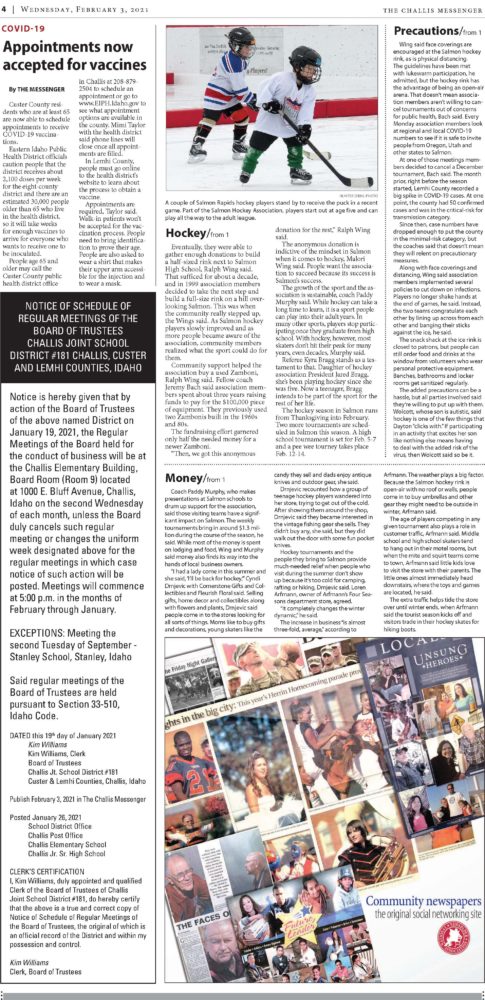Challis Messenger February 3, 2021


USA Hockey Magazine – Cover Story – January 2007
Cover Story

Fresh Salmon
The Heartbeat Of Salmon, Idaho, Can Be Found In Its Small Town Pride And Love Affair With Hockey
By Joel Willits • Photos By Brandon Hansen
In 1989, seven skaters in secondhand gear took the ice. Ranging in ages from 5 to their mid-teens, the ragtag group of skaters was a team in name only.
Mittens were used in place of hockey gloves. Their goalie, when one could be found, took the crease with newspapers duct taped to his shins.
Skating on an outside rink, the team was at the mercy of Mother Nature when it came to ice time.
It would be two years before any of them would even score their first goal.
Thirteen years later, four of the boys on that team brought the town its first state championship.
An inspiring story, to be sure, but spend one winter’s afternoon in this small rural community at the base of the Continental Divide and it’s easy to see that nothing is impossible for those who dream big.
Welcome to Salmon, Idaho, a town where hockey is still played the way it was meant to be.

The River Of No Return
Nestled deep in the Salmon Valley in the mountains of Central Idaho, Salmon is the birthplace of Sacajawea, the Indian guide who led Lewis & Clark through the rugged northwest all the way to the Pacific Ocean.
It is a slice of rural America, where bake sales and high school football games would seem more prevalent than ice hockey. That’s not necessarily the case, thanks to the river that twists its way through the city of the same name.
Known appropriately as “The River of No Return” for its fast rapids, the river both entertains the town’s 3,300 residents and serves as its lifeblood. The river also happened to be the catalyst in forming organized hockey in Salmon.
“Basically there was a group of guys in our early 20s. We were skating on the public rink on the island right next to the river,” recalls Salmon hockey president Steve Walsh. “We didn’t have nets to shoot on; we just put up a couple of boots [as goals]. We would literally lose all of our pucks in the river.”
Stretching out across the ice to retrieve lost pucks soon got old, and the suggestion to build a real rink with boards began to pick up steam.
It was the birth of Salmon hockey.
The Beginnings
The original half-sized rink was built adjacent to Salmon High School, home of the Savages, and was constructed using anything the hockey men could get their hands on.
“We begged and borrowed to get the fence posts to put up the rink boards,” Walsh says. “We didn’t determine the size of the rink, the plywood supply did.”
In 1989, the last nail was pounded and Salmon hockey fielded its first youth team. It was an all-age encompassing squad, and like the rink itself, was decked out in whatever equipment could be found.
“We didn’t have enough gear,” recalls Kathryn Blackadar, 23, who, along with her twin brother, Bill, was an original member of Salmon hockey.
“When Bill wanted to play, there just wasn’t any more gear. So the entire first year, we just switched off wearing the gear every practice.”
There were other growing pains associated with bringing hockey to Salmon. The team struggled mightily, but in the end it was all about having fun.
“We would go to Idaho Falls and just get slaughtered. I mean absolutely slaughtered. But we didn’t care,” Blackadar says.
“The first time we scored a goal was in Idaho Falls, and the place just went nuts,” adds Walsh, whose son Brian was the first USA Hockey registered member in Salmon.
“It wasn’t just Salmon people either. That place just erupted for us. I’m getting goose bumps just talking about it.”

A Community United
It wasn’t long before Salmon hockey outgrew the old plywood rink. The construction of the new rink and the ongoing upgrade effort soon followed.
A new location was selected on the hill overlooking the town. This time, the rink would be a full-sized ice sheet, but it would remain an outdoor facility.
“When we made the move from the high school rink to where we are now, I bet there were 40 people coming out with trailers and backhoes, and we just got it done,” says Gary Van Huffel, Salmon’s City Administrator and an adult hockey player. “I’ve never seen the community come together like that for anything else before.”
Over the next few years, various rink projects were undertaken, such as constructing outdoor lighting and the purchase of a used 1968 Zamboni to scrape the ice, replacing the numerous adult volunteers who would cut the ice using shovels and good old fashioned hard work.
The outdoor rink soon had heated locker rooms as well as a firepit where spectators could warm up while taking in the game. One of the best features the facility offered was the addition of a 35,000 square foot public ice sheet, located a snowball’s throw away from the main rink.
“It’s just another example of what makes small communities great,” Van Huffel says. “When it snows, everyone just comes out to the rink with shovels.”
Still, playing outside did have its disadvantages. The weather often dictated when the kids could hit the ice, and oftentimes that came around mid-December at the earliest.
“Other teams had been skating for almost three months before our kids hit the ice,” says former Salmon hockey president Annie Pflueger. “It was obvious we needed a refrigeration system.”
In 2003-04, the board of the hockey association and all the parents, fans and players began the hundreds of hours of fund-raising efforts, and in one year’s time, the community pulled together more than $100,000, including a $25,000 grant from the National Hockey League Players Association’s Goals and Dreams fund.
Finally, after years of being at the mercy of the fickle Idaho weather, Salmon achieved its goal and had ice it could depend on.

A Source Of Civic Pride
“Getting refrigeration really showed the community that Salmon Hockey was here to stay,” Walsh boasts. “Before, it was hard for the business community to take us seriously when we couldn’t even depend on the ice because of the weather.”
Now, with dependable ice, the entire community has pitched in to support the hockey program, and hockey, in turn, has done wonders for the local businesses.
“Salmon needed something in the winter time. We lost our timber economy and we lost our mining economy,” says Salmon mayor Stan Davis. “Salmon needed something for the businesses, whether it was eating a burger in the café or staying the night in the local inns.”
“I just love what the hockey folks are doing,” adds Nick Bertram, owner of Bertram’s Brewery and grandfather of a Salmon hockey player. “We are isolated; a long way from anywhere. I think what they have done for the kids and our community is fantastic.”
A Championship For Salmon
Kathryn Blackadar stopped playing hockey with the boys, but that didn’t mean she wasn’t close with her former teammates. Bill was still playing in 2002 when his team faced off in the Idaho State Championship semifinals in Boise against a Sun Valley team that Salmon had not defeated that season.
“We weren’t even expecting the boys to get into the championship game,” Blackadar says. “So when we beat Sun Valley, 4-0, it felt like the championship to a lot of us.”
Salmon then faced off against state powerhouse Idaho Falls, a team that picks its Midget team from a pool of more than 100 players, for the state championship.
The game went into double-overtime tied at 3-3. Salmon’s D.W. Cook capped off the first hat trick of his young hockey career when he launched the winning goal into the back of the net, bringing Salmon its first state championship and cementing the game’s place in community lore.
“It was just phenomenal. People were crying and screaming. It was just amazing,” Blackadar recalls. “The team was just so bad to begin with, and they beat the best teams in Idaho.”
“I think the championship was the first time that hockey was really recognized in Salmon,” says Doug Sholes, who coached the Midget team.
“I don’t think people really realized how important that championship was at the time,” Walsh adds. “Salmon was kind of a football and basketball town, and I think that championship really helped change things.”
Salmon has since enjoyed additional state championships, with the girls winning the title in 2005 and the Bantam squad winning in 2006.
It’s fairly remarkable given the size of the Salmon program. Their numbers in any age level generally run from 12 to 15. This year’s Bantam squad has 11 players, while the Midget team tops off at 20 players, a first for Salmon.
Mystery, Idaho
The true feel of Salmon though can be found in the heart of the players and the mystique of the town.
“Having an outdoor rink is awesome, and I love skating on it,” says 13 year-old Hayden Aldous. “I like to be outdoors anyway, so I really like playing on our rink.”
First-year skater Zach Miner, 10, got tired of watching the games, so the son of the high school football coach strapped on the skates and got into the action.
“Playing indoors is warmer, but there is no way it is as fun as this,” says Miner. “Yesterday I was able to skate for six hours.”

Bantam players Hayden Aldous and Chris Wilson.
Such is commonplace in Salmon. When games are not in progress, anyone is welcome to use the rink to shoot around, get some extra skating in or play a game of shinny.
“The high school uses it for its lifetime sports class, and some of the churches use it as well,” says Walsh. “We don’t ask for anything for it.”
Hockey in Salmon is also more affordable than anywhere else in Idaho, with fees of only $100 a year, which is important for the town that has seen its share of hard times.
“Dollars are hard to come by in Salmon,” says Davis who is in his 12th year as Salmon’s mayor. “But we always put our children first.”
The next big challenge for Salmon is to acquire a roof, Walsh says, to help keep the ice in the best shape possible.
“We desperately need a roof, but we don’t want walls,” Walsh says. “We don’t want to become another metal building with a hockey rink sitting inside. We want to maintain our outside rink. It is a pie in the sky dream to us right now, but so was refrigeration.”
Salmon hockey has come a long way since the days of fishing pucks out of the river. The evolution of its rink and its teams is a source of local pride. It’s a testament to what can be accomplished when people work together for a common goal.
Joel Willits is a freelance writer in eastern Washington.